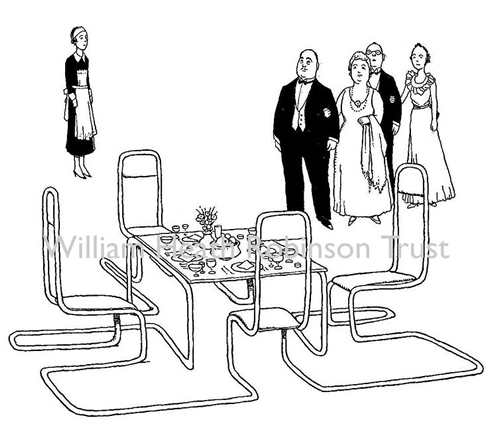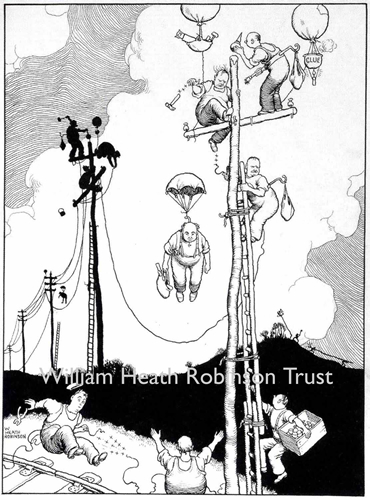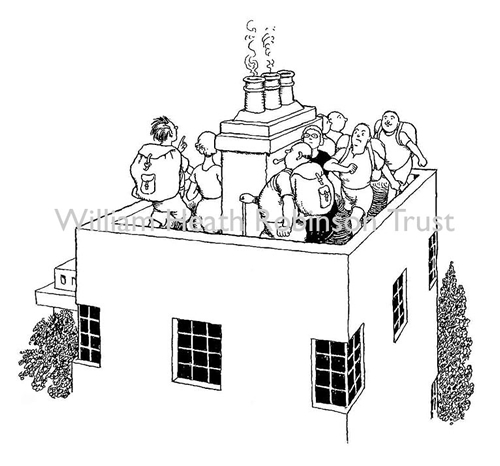 Homepage Homepage
 About the Trust About the Trust
 W H Robinson W H Robinson
 Museum Museum
 Image Gallery Image Gallery
 Recent Acquisitions Recent Acquisitions
 Touring Exhibition Touring Exhibition
 Contact Us Contact Us
  |

Blow, winds, and crack your cheeks! rage! blow!
Pen, ink and watercolour.
An unpublished illustration for King Lear.
One of the first projects of the publishing house of Jonathan Cape was to be The Works of Shakespeare illustrated by W Heath Robinson. Work started on the commission in January 1921 and the drawings were finally completed in June 1922, but either because of the lack of a US partner, or because of the declining market for illustrated books, the edition was never published.

The little robber-maiden.
Pen, ink and watercolour.
Published in Hans Andersens Fairy Tales.
Constable & Co., 1913.
This drawing illustrates a scene in the Fifth Part of “The Snow Queen’. It was coloured for exhibition after publication of the book.

The one-piece chromium steel dining suite.
Pen and ink.
Published in How to Live in a Flat by W Heath
Robinson and KRG Browne, Hutchinson & Co, 1936.
The book has an extended section which explores the possibilities of tubular steel furniture, including a chair with a tap on the side providing a continuous supply of beer through the tubular frame from a barrel in the basement below.

Installing the electric telegraph between Paddington and Slough.
Pen and ink.
Published in Railway Ribaldry by William Heath Robinson, GWR, Paddington Station, 1935.
In 1935 the Great Western Railway Company commissioned Heath Robinson to make a collection of drawings illustrating the history of the company to mark its 150th anniversary.

Roof hiking in a modern flat.
Pen and ink.
Published in How to Live in a Flat by W Heath Robinson and KRG Browne, Hutchinson & Co, 1936.
“Hiking—the art or science of going for a walk rather more ostentatiously than our forefathers thought necessary. A moment’s reflection will show that one can hike just as thoroughly on a flat roof as in the Kalahari Desert, and at a far more reasonable cost. The roof-hiker, moreover, has this added consolation—that when overcome by general lassitude, corns on the soles of his feet, or a sense of the sheer futility of Life, he is spared that irksome journey home which has been so aptly described as the end of an imperfect day. All he has to do is to open the nearest trapdoor and pop downstairs, shouting for his slippers.“

The Fairy's Birthday.
Pen, ink and watercolour.
Published in Holly Leaves, Dec 1925, p21.
Heath Robinson’s goblins appeared in the Christmas Numbers of a variety of magazines between 1919 and 1929. They are distinguished by their homely and somewhat bumbling appearance. They may be short-sighted, overweight and suffer from pains in their joints or shortness of breath. They have a rustic quality and may well have been based on the characters that Heath Robinson met in and around Cranleigh.

Sixth Adventure – The Mer-boys’ School
Pen and ink. Coloured later for exhibition.
Published in The Adventures of Uncle Lubin, 1902, pp60-61.
Uncle Lubin determined to look for little Peter in the depths of the sea, so he built himself a submarine. One day he came upon a shoal of little mer-children. One little mer-boy told him a sad story. “Until quite lately,” he said, “I and my brothers went to a school kept by a very wise old mer-man, who did his best to teach us all we ought to know. . .
|